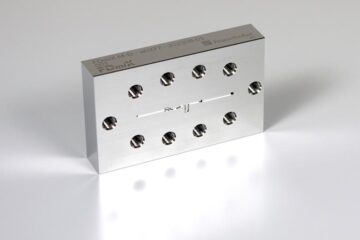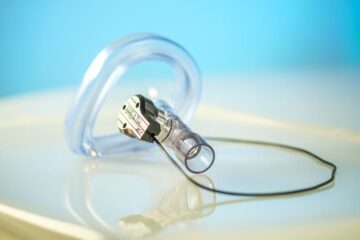Odyssey finds widespread water

Odessey reached Mars in October 2001. <br>© NASA <br>
Latest probe sends back strong evidence for lots of ice beneath Mars’ surface.
Mars is icy. Not just on its white-capped poles, according to the first images beamed back from NASA’s Mars Odyssey spacecraft.
The gamma ray spectrometer (GRS) on Odyssey detects chemicals on, or just below Mars’ surface. It has found signs of large amounts of hydrogen. „It’s most probably indicative of water ice,“ says Jeffrey Plaut, deputy project scientist for Odyssey.
The hints of hydrogen stretch to Mars’ mid-latitudes – roughly equivalent to the UK’s latitude on Earth. Many experts thought that water ice would only persist around the planet’s permanently frozen poles.
Others are unsurprised. „It doesn’t come as a great shock to me, says Colin Pillinger, of the Open University in Milton Keynes, England. „We’ve always suspected that there’s ice there,“ he says.
The hydrogen signal dies out over the poles. This is probably due to frozen carbon dioxide gas lying on top of water ice masking it from view, the researchers conclude.
Odyssey arrived at Mars in late October 2001. It has only just begun to send back data.
Global warming
Also on Odyssey is the Thermal Emission Imaging system (THEMIS). This infrared camera can infer the composition of various rocks and dust on Mars from how they lose and absorb heat between the harsh Martian nights and days.
THEMIS is revealing Martian surface details not seen before. „We’re very pleased with its performance,“ says Plaut. Scientists hope it will also show whether previously identified volcanic areas on Mars are still warm.
Such internal warmth could melt Martian permafrost, offering the best environment for life. „Warm regions provide the greatest potential for looking for life,“ says astrobiologist Richard Taylor of the Probability Research Group in England.
„Odyssey data could completely change our view of Mars,“ hopes Taylor. Existing probes like Mars Global Surveyor have made close-up measurements of the planet. But Odyssey will be the first to make global high-resolution studies.
Odyssey is not firing on all cylinders however. Its third instrument, the Mars Radiation Environment Experiment (MARIE) is broken. It worked all the way to Mars, and even sent back data on powerful radiation fields around the planet that could be lethal to manned flights. But is now failing to respond to signals from the ground.
Media Contact
Alle Nachrichten aus der Kategorie: Physik Astronomie
Von grundlegenden Gesetzen der Natur, ihre elementaren Bausteine und deren Wechselwirkungen, den Eigenschaften und dem Verhalten von Materie über Felder in Raum und Zeit bis hin zur Struktur von Raum und Zeit selbst.
Der innovations report bietet Ihnen hierzu interessante Berichte und Artikel, unter anderem zu den Teilbereichen: Astrophysik, Lasertechnologie, Kernphysik, Quantenphysik, Nanotechnologie, Teilchenphysik, Festkörperphysik, Mars, Venus, und Hubble.
Neueste Beiträge

FDmiX: Schnelle und robuste Serienproduktion von Nanopartikeln
Verkapselungstechnologie der nächsten Generation… Nukleinsäure-basierte Medikamente wie mRNA-Impfstoffe bieten ein enormes Potenzial für die Medizin und eröffnen neue Therapieansätze. Damit diese Wirkstoffe gezielt in die Körperzellen transportiert werden können, müssen…

Sensor misst Sauerstoffgehalt in der Atemluft
Eine zu geringe oder zu hohe Sauerstoffsättigung im Blut kann bleibende körperliche Schäden bewirken und sogar zum Tod führen. In der Intensiv- und Unfallmedizin wird die Sauerstoffkonzentration der Patientinnen und…

Neue MRT-Technik erkennt Schlaganfälle in kürzester Zeit
Tag gegen den Schlaganfall: Forschende der Universitätsmedizin Mainz haben im Rahmen einer Studie erstmals eine KI-gestützte Magnetresonanz-Tomographie (MRT)-Methode untersucht, um akute ischämische Schlaganfälle effizienter detektieren zu können. Dabei setzten sie…





















